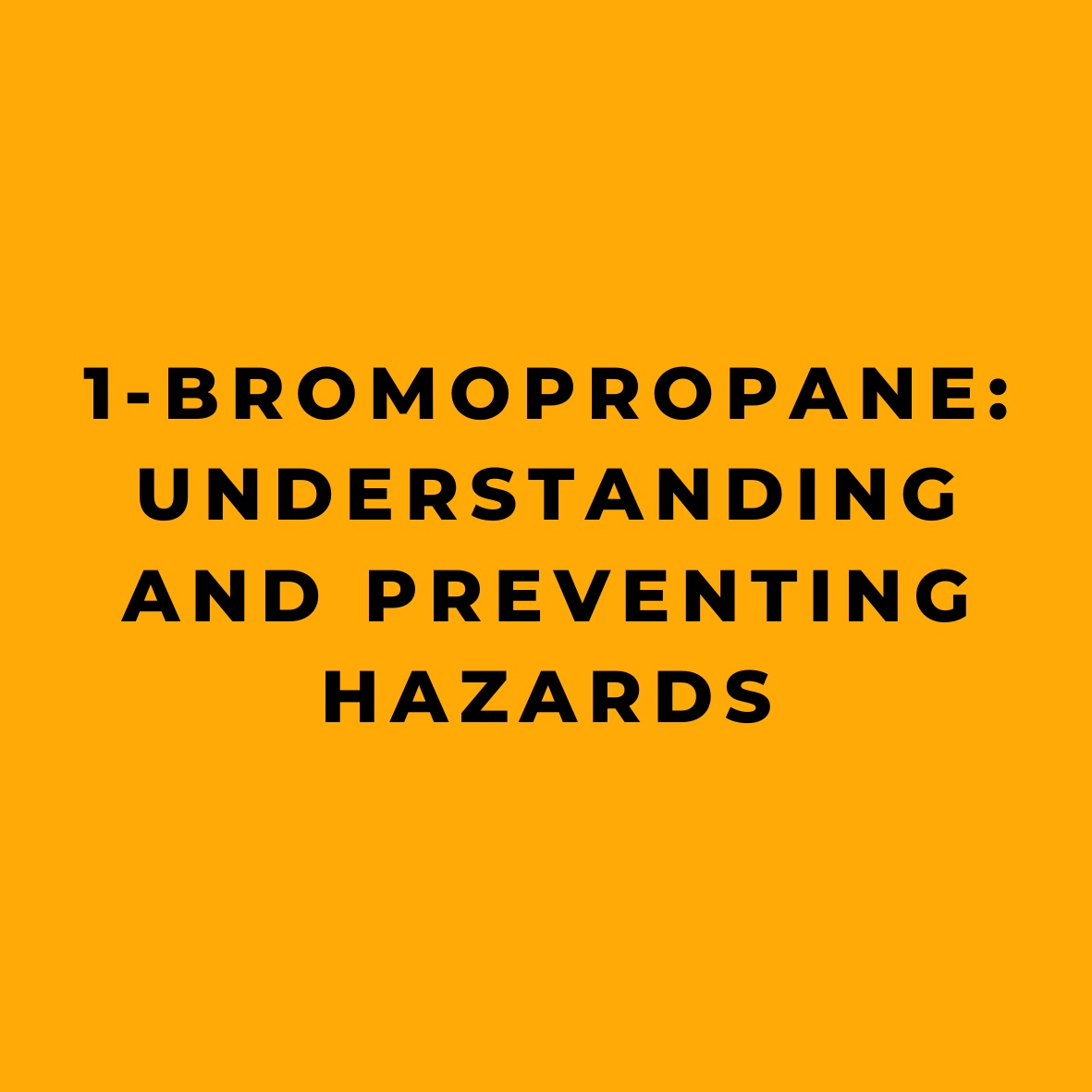I want to talk to you about something serious—a chemical called 1-Bromopropane, also known as 1-BP. You may not have heard of it, but trust me, it’s important to know about, especially if you work in certain industries. So, let’s dive in and learn about this chemical, its health effects, and how to stay safe.
1-BP is a versatile solvent that’s commonly used in degreasing, dry cleaning, spray adhesives, and aerosol solvents. It’s become more popular in workplaces over the past couple of decades, but here’s the catch—it’s been linked to some nasty health effects, including neurological illnesses, cancer, and reproductive disorders.
Now, let me break it down for you. 1-BP is often found in products used for vapor and immersion degreasing (cleaning metals, plastics, and electronic components), adhesive spray applications, dry cleaning, and solvent sprays for operations like asphalt production, aircraft maintenance, and synthetic fiber manufacturing. The chemical is also known by another name—n-propyl bromide or nPB2.
The big problem with 1-BP is that exposure to it can cause irritation to the eyes, mucous membranes, upper airways, and skin. But it gets worse—prolonged exposure to 1-BP can damage the nervous system, leading to headaches, dizziness, slurred speech, loss of consciousness, difficulty walking, muscle twitching, and even loss of feeling in arms and legs. These neurological effects may persist long after exposure has ended.
Let me tell you about a case study. Six workers were exposed to 1-BP vapors from spray adhesives, and they experienced neurotoxicity. They complained of lower extremity pain, difficulty walking, muscle twitching, and other symptoms. After two years, some of the workers still had trouble walking and felt pain most of the time. It’s no joke, folks—this stuff is dangerous.
So how do workers get exposed to 1-BP? Well, it’s usually through breathing in the vapor or mists of the spray. But skin contact is also a concern, as 1-BP can be absorbed through the skin. The longer a worker is exposed to 1-BP, the higher the risk of health effects, with some symptoms showing up after just two days of exposure.
Now, you might be wondering, what’s being done to protect workers? Well, Federal OSHA doesn’t have a specific exposure standard for 1-BP, but employers are legally required to keep their workers safe from this hazard. In California, for example, there’s a limit of 5 parts per million (ppm) for 1-BP exposure, with a skin notation to protect workers from skin contact. Other organizations, like the American Conference of Governmental Industrial Hygienists (ACGIH), recommend a 10 ppm limit and are considering lowering it further to 0.1 ppm.
One important tool for worker safety is training and education. Under the Occupational Safety and Health Act, employers must provide health and safety information to workers who may be exposed to hazardous materials like 1-BP. Safety Data Sheets (SDS) must be made available, and workers must be trained on the health hazards and proper use of equipment to reduce exposure. Employers must also provide training in a manner and language that workers understand the potential health effects of 1-BP exposure. If a worker reports health issues after being exposed to 1-BP, they should be referred to a doctor or nurse with expertise in occupational or environmental medicine. A thorough occupational history should be part of the evaluation, especially if a worker has unexplained or nonspecific neurologic symptoms. Healthcare providers should report findings to the affected worker and provide summaries of potential work-related health effects to employers, with personal identifiers removed.
Of course, the best approach is to prevent exposure in the first place, and that starts with evaluating exposure in the workplace. It’s crucial to identify potential hazards and estimate the level of those hazards. Worker exposures to 1-BP in the air and through skin contact should be measured, and biological monitoring (such as measuring 1-BP and its metabolites in urine) can be a useful tool for evaluating exposure. If the hazard needs to be controlled, employers should take necessary steps to reduce exposure and protect workers.
We also need to be vigilant about monitoring and documenting exposure levels at various worksites. Some studies have shown that workers near degreasers or those involved in adhesive spray applications may experience concentrations of 1-BP that exceed recommended levels. For example, in one study, foam cushion fabrication workers were exposed to concentrations ranging from 92 to 127 parts per million (ppm).
So what can we do? Well, if you’re an employer, it’s your responsibility to ensure that your workers are informed about the hazards of 1-BP, and that they have the necessary personal protective equipment (PPE) to stay safe on the job. Consider alternatives to 1-BP where possible, and implement engineering controls such as ventilation systems to reduce exposure. Make sure that safety protocols are in place, and that all workers are trained to handle hazardous materials safely.
Safeguarding with Personal Protective Gear (PPE)
When engineering solutions are in the works or under repair, when both engineering and managerial protocols, as well as work practices, fail to sufficiently diminish exposure, or when such measures prove impractical, PPE serves as a temporary measure.
Breathing Safeguards:
- In situations where respiratory protection is vital for worker health or mandated by employers, the employer is responsible for supplying the necessary respirators. Additionally, employers must adhere to a written respiratory protection plan aligned with OSHA’s Respiratory Protection standard (29 CFR 1910.134). This plan encompasses written guidelines, proper respirator selection and maintenance, fit assessments, health evaluations, cartridge replacement schedules, a designated program overseer, and education.
- For settings where respirators are required, yet the atmosphere isn’t acutely life-threatening, workers must utilize air-purifying respirators certified by NIOSH or NIOSH-approved supplied-air respirators with the appropriate protection factor assigned. 29 CFR 1910.134(d)(1)(ii), 1910.134(d)(3)(i)(A). These criteria-compliant respirators include those equipped with organic vapor cartridges.
Dermal Safeguards:
- Given 1-BP’s tendency to absorb rapidly through human epidermis, it is vital to wear chemical-resistant gloves, sleeves, aprons, and other suitable attire to mitigate skin contact.
- 1-BP has the capacity to permeate most glove materials. For defense against 1-BP, experts recommend gloves made from supported polyvinyl alcohol or multi-layered laminates.
Suggestions for Engineering Controls:
Picture this: you’re a worker surrounded by airborne contaminants, and you’re in dire need of a solution to keep you safe. That’s where engineering controls come into play, reducing exposure to these pesky pollutants by either stopping them at their source or keeping them far from where you’re working.
Now, there’s a whole slew of engineering controls we can consider, so let’s break ’em down.
- Isolation: First up, we’ve got Isolation. Think of it as a superhero power for the workplace. By separating machinery using 1-BP from other areas, you’re shielding workers who aren’t using that equipment from exposure. But hold on – when you’re setting up these isolation zones, don’t forget to think about exhaust ventilation to keep the isolated area from becoming a contamination hotspot.
- Ventilation: Next, let’s talk Ventilation. For top-notch design and installation of ventilation systems like local exhaust ventilation, you’re gonna want some experts on your side. And don’t forget to keep up with routine maintenance to make sure everything’s running smoothly.
- Other Controls: Now, there’s a bunch of other engineering controls that could be just what the doctor ordered, depending on your workplace. For instance, if you’re using vapor degreasing systems, think about automatic-controlled hoists, sliding or rolling covers, and keeping those cooling coils in tip-top shape. And for dry cleaning operators with 1-BP, get a qualified technician to manage the conversion of machines that used a different solvent. Features that help reduce exposure include safety switches, interlocks, filtration systems, filling devices, and gaskets and seals resistant to 1-BP, as well as process controls.
And finally, don’t just set it and forget it. After installing engineering controls, it’s crucial to periodically re-evaluate worker exposure to 1-BP to make sure those controls are still doing their job.
If you’re a worker, be proactive about your safety. Ask questions, learn about the hazards you may face on the job, and understand how to use PPE effectively. Pay attention to safety training, and don’t hesitate to speak up if you have concerns about your work environment. Remember, your health and safety come first.
Administrative Controls
Alright, folks, now let’s dive into the world of Administrative Controls. These bad boys are all about work practices and policies that help keep you safe from workplace hazards. So, if your workplace is using 1-BP, here are some administrative controls you should definitely consider:
Reduce Exposure: First off, let’s talk about exposure. You’ll want to cut down the time a worker spends around 1-BP, and keep the number of workers exposed to a minimum. It’s like a tag-team match, but with chemicals.
Reduce Usage and Storage: Next, think about your 1-BP usage. Try to buy, store, and use only what you need – the less, the better. And remember, when you’re not using it, keep those containers sealed up tight.
Now, for all you dry cleaning operators out there, here are some tips to avoid a 1-BP showdown:
- Don’t let that solvent overheat – it’s like a ticking time bomb.
- And whatever you do, don’t shorten those drying periods. Patience is a virtue, my friends.
So, there you have it – Administrative Controls in a nutshell.
Conclusion
In conclusion, 1-Bromopropane is a chemical that has some valuable industrial applications, but it’s not without risks. It’s important for all of us to be aware of those risks and take appropriate measures to protect ourselves and others. Together, we can create safer workplaces and promote the well-being of workers across the country.
References:










